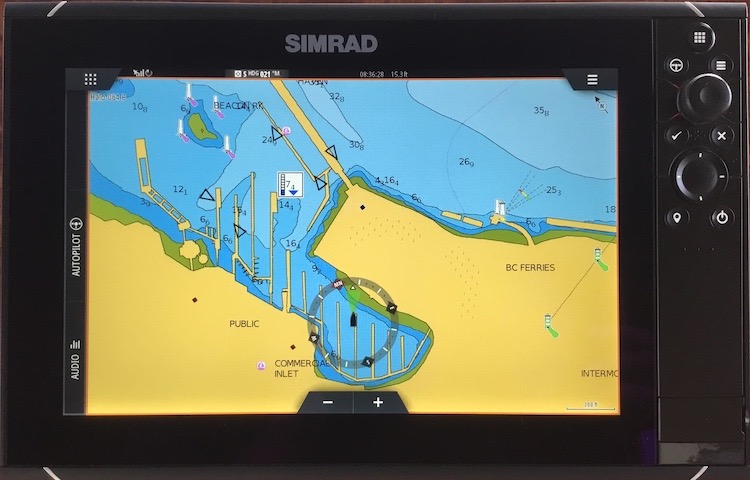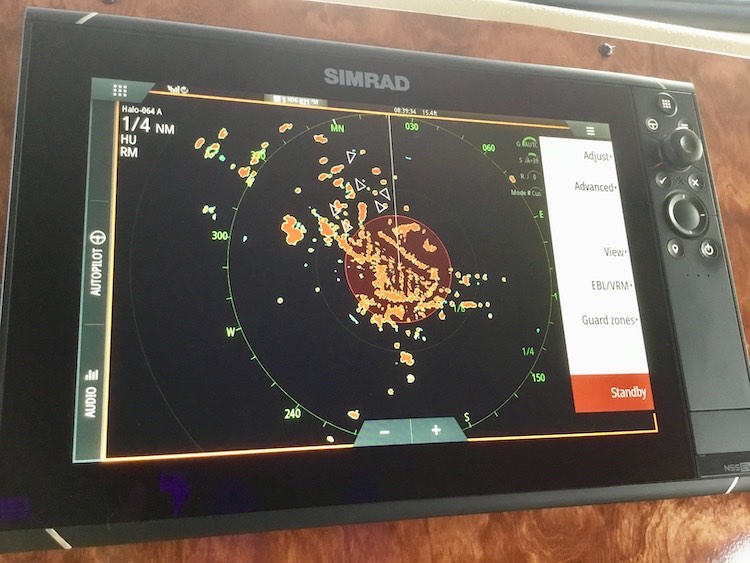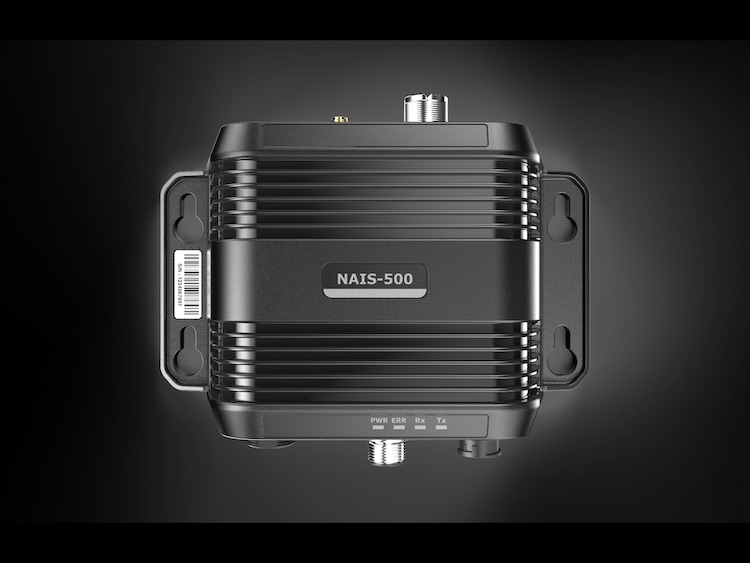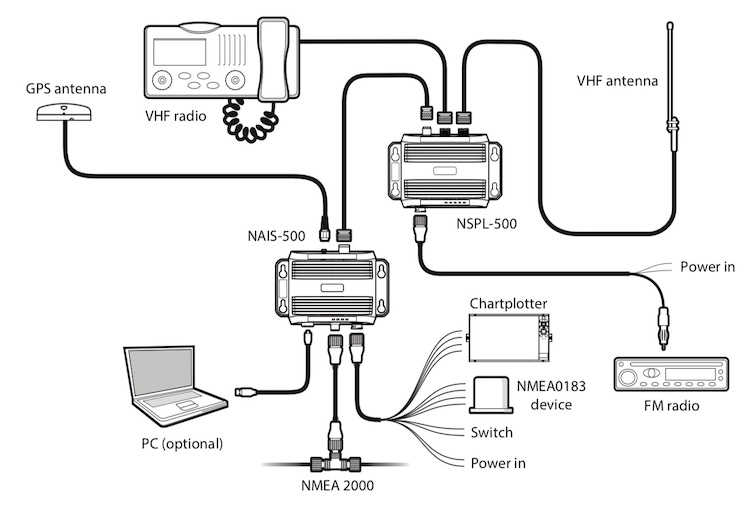
Safety at sea means knowing your surroundings. This may start with eyes on the water and improve with a GPS-based chart plotter and sounder, but there is a lot to be said for instantly and immediately being able to determine another ship’s location and heading in relation to your own vessel. That is where an Automatic Identification System (AIS) comes into play. It’s another tool in the collision avoidance game, and an excellent companion to marine radar.
What is AIS?
When an AIS receiver is integrated into your marine electronics system, other vessels equipped with an AIS transmitter are shown on your multifunction display as isosceles triangles. AIS targets are viewable on chart pages and radar screens (see AIS on Chart Plotter and AIS on Radar below).
Using the keypad or touchscreen functions to highlight the triangular AIS targets will open a window that displays critical vessel information. This will include the name of the ship, the Maritime Mobile Service Identity (MMSI) number (or call sign), its overall length width and height, heading, speed, and current activity (in-tow, at anchor, etc.). Vital collision avoidance information is provided as closest point of approach (CPA), given as an estimated minimum distance, and time to closest point of approach (TCPA)—shorter distances and shorter times represent bigger threats of collision (AIS Vessel Details).
Without the use of a chart plotter, one can see AIS in action from home by using the www.marinetraffic.com website. Receivers are available as black box units or integrated into a VHF radio.
How Does AIS Work?
AIS is a marriage of GPS and VHF radio technologies. Using a dedicated GPS antenna to fix a position and heading, the AIS transmitter converts all relevant data into a digital signal that is broadcast on VHF channels 87B and 88B. These channels do not affect communications on 87A or 88A. A run of the mill VHF antenna is sufficient to broadcast and receive this data. Antennas tuned specifically to these frequencies are available for those seeking in the farthest-reaching transmissions. Data that has been acquired by AIS receivers is then converted to a NMEA 0183 sentence or NMEA 2000 PGN for use on your marine electronics network.
Is AIS Required by Law?
Some ships are required by law to transmit an AIS signal. It has long been a requirement for large vessels, and the use of AIS is about to become widespread. In a May 14 Ship Safety Bulletin (SSB No.:09/2019), Transport Canada (the governing body for marine traffic) announced a new requirement for AIS carriage, with a deadline of June 15, 2019. Affected vessels include those that are operating outside of sheltered waters and are either certified to carry more than 12 passengers or are 8 metres in length (or greater) and carrying any number of passengers.
To clarify the above, for the purpose of the regulations “sheltered waters” are defined as areas above tidal waters, rivers, and lakes where the vessel can never be further than 1 nautical mile from shore. There are a few exemptions within our tidal waters that are classified as sheltered waters, and those can be found in Schedule 1 and Schedule 2 of the Vessel Certificates Regulations. The vast majority of our coast is not considered to be “sheltered waters.” Passengers include anyone in any situation who is providing any form of compensation for their travel aboard. This will mean any fishing guide, whale-watching vessel, charter boat, ferry service, or those requiring remuneration for fuel and/or other expenses related to transportation of people aboard boats greater than 8 metres will require, by law, an AIS transceiver in operable condition aboard their boats.
What Are The Benefits?
By transmitting an AIS signal, you have made yourself far more visible on the water. This has immediate safety benefits, especially in inclement weather and larger waves; often a smaller pleasure craft or commercial vessel will be lost to radar in the trough of a wave; likewise, heavy rain, salt spray, or fog can reduce the size of your radar return. When the weather is calm, smooth, and sunny, AIS transmissions can allow your friends to keep track of your movements. If the fishing is great, it’s easy to share the hotspot, and in the event of an emergency or mechanical breakdown, valuable minutes can be saved in the rescue effort. You may at this point be thinking to yourself “I don’t want to give up my halibut spot to all of the boats around me!” Most transceivers have the option to employ a toggle switch to go in “pirate mode,” ceasing the transmission of data over VHF frequencies, while still maintain your ability to receive and display other targets. Your secret remains safe.
How Much Does AIS Cost?
If you need or want AIS features on board, you are no doubt wondering about the cost associated with the upgrade. To receive only, a person only needs to acquire a VHF radio with an integrated AIS receiver. Targets can be seen on the display of the radio itself, without connection to the chart plotter, although one is highly recommended. The transponders (to transmit and receive) will cost in the ballpark of $1,000, depending on features and manufacturers. My personal preference is the Simrad NAIS-500.
It is compact, lightweight, waterproof, draws low current operates between 9.6 and 32.1 volts DC, and integrates with your existing navigation system via NMEA 2000, NMEA0183, or USB. Other considerations in cost will be the installation of either a second VHF antenna—which is preferred for preserving strength of VHF radio transmissions and redundancy reasons (as little as $100)—or the addition of an inline, active VHF splitter to share an existing antenna (at around $300). Installation time varies from boat to boat, but will include mounting of the GPS puck, providing a reliable fused connection to power and ground, connecting a VHF antenna, supplying a data connection to your navigation system, and if desired, the mounting and connection of a switch for pirate mode. A laptop computer with a USB connection will be required to program the details of your vessel and enter the MMSI number to enable transmissions. No subscription fee is required to make use of this service. Figures below picture typical installations with or without VHF Splitters.
Steve Maas is the operator of Moose Marine Electrical in Nanaimo, B.C. Contact Moose at (250) 668-3821 for profesional installation of marine electronics.
Visit the Store
$34.99
$34.99
Featured Catch

Joel Unickow halibut (Photo: Rob Frawley Lucky Strike Sportfishing Tofino)












